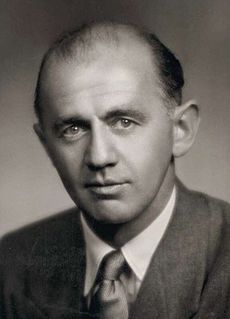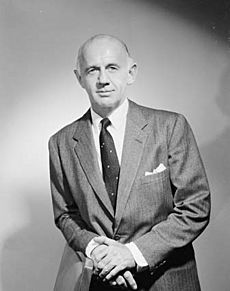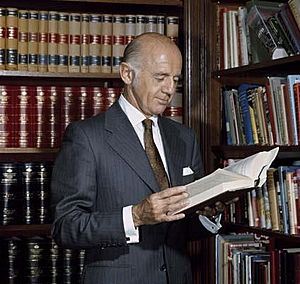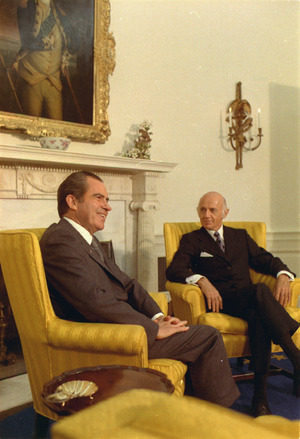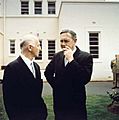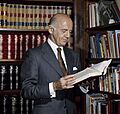William McMahon facts for kids
Quick facts for kids
Major the Right Honourable Sir
William McMahon
|
|||||||||||||||||||||||||||||||||||||||||||||||||||||||||||||||||||||||||
|---|---|---|---|---|---|---|---|---|---|---|---|---|---|---|---|---|---|---|---|---|---|---|---|---|---|---|---|---|---|---|---|---|---|---|---|---|---|---|---|---|---|---|---|---|---|---|---|---|---|---|---|---|---|---|---|---|---|---|---|---|---|---|---|---|---|---|---|---|---|---|---|---|---|
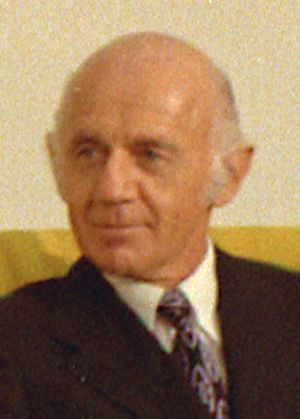
McMahon in 1971
|
|||||||||||||||||||||||||||||||||||||||||||||||||||||||||||||||||||||||||
| 20th Prime Minister of Australia | |||||||||||||||||||||||||||||||||||||||||||||||||||||||||||||||||||||||||
| In office 10 March 1971 – 5 December 1972 |
|||||||||||||||||||||||||||||||||||||||||||||||||||||||||||||||||||||||||
| Monarch | Elizabeth II | ||||||||||||||||||||||||||||||||||||||||||||||||||||||||||||||||||||||||
| Governor-General | Sir Paul Hasluck | ||||||||||||||||||||||||||||||||||||||||||||||||||||||||||||||||||||||||
| Deputy | Doug Anthony | ||||||||||||||||||||||||||||||||||||||||||||||||||||||||||||||||||||||||
| Preceded by | John Gorton | ||||||||||||||||||||||||||||||||||||||||||||||||||||||||||||||||||||||||
| Succeeded by | Gough Whitlam | ||||||||||||||||||||||||||||||||||||||||||||||||||||||||||||||||||||||||
|
|||||||||||||||||||||||||||||||||||||||||||||||||||||||||||||||||||||||||
|
|||||||||||||||||||||||||||||||||||||||||||||||||||||||||||||||||||||||||
|
|||||||||||||||||||||||||||||||||||||||||||||||||||||||||||||||||||||||||
| Personal details | |||||||||||||||||||||||||||||||||||||||||||||||||||||||||||||||||||||||||
| Born | 23 February 1908 Redfern, New South Wales, Australia |
||||||||||||||||||||||||||||||||||||||||||||||||||||||||||||||||||||||||
| Died | 31 March 1988 (aged 80) Potts Point, New South Wales, Australia |
||||||||||||||||||||||||||||||||||||||||||||||||||||||||||||||||||||||||
| Political party | Liberal | ||||||||||||||||||||||||||||||||||||||||||||||||||||||||||||||||||||||||
| Spouse |
Sonia Hopkins
(m. 1965) |
||||||||||||||||||||||||||||||||||||||||||||||||||||||||||||||||||||||||
| Children | 3, including Julian | ||||||||||||||||||||||||||||||||||||||||||||||||||||||||||||||||||||||||
| Alma mater | University of Sydney | ||||||||||||||||||||||||||||||||||||||||||||||||||||||||||||||||||||||||
| Profession | Lawyer | ||||||||||||||||||||||||||||||||||||||||||||||||||||||||||||||||||||||||
| Military service | |||||||||||||||||||||||||||||||||||||||||||||||||||||||||||||||||||||||||
| Branch/service | Australian Imperial Force | ||||||||||||||||||||||||||||||||||||||||||||||||||||||||||||||||||||||||
| Years of service | 1940–1945 | ||||||||||||||||||||||||||||||||||||||||||||||||||||||||||||||||||||||||
| Rank | Major | ||||||||||||||||||||||||||||||||||||||||||||||||||||||||||||||||||||||||
| Unit | 6th Division | ||||||||||||||||||||||||||||||||||||||||||||||||||||||||||||||||||||||||
| Battles/wars | World War II | ||||||||||||||||||||||||||||||||||||||||||||||||||||||||||||||||||||||||
Sir William McMahon (born 23 February 1908, died 31 March 1988) was an important Australian politician. He served as the 20th Prime Minister of Australia from 1971 to 1972. He was also the leader of the Liberal Party during this time.
McMahon had a very long career in government, serving as a minister for over 21 years. This is one of the longest times anyone has continuously served as a minister in Australian history.
He was born and grew up in Sydney. Before becoming a politician, he worked as a lawyer. During World War II, he served in the Australian Army and became a major. After the war, he studied economics at university.
In 1949, McMahon was elected to the House of Representatives. He became a minister in 1951 and joined the main cabinet in 1956. He held many different jobs in the government led by Robert Menzies. One of his key roles was Minister for Labour and National Service from 1958 to 1966. In this job, he helped bring back conscription (compulsory military service) in 1964.
In 1966, Harold Holt became Prime Minister, and McMahon became the deputy leader of the Liberal Party. He was made Treasurer of Australia, which meant he was in charge of the country's money. He helped reduce the national debt during this time. After Holt's death in 1967, McMahon wanted to become Prime Minister. However, John McEwen, the leader of the Country Party, did not support him. So, John Gorton became the new Prime Minister.
McMahon continued as Treasurer for a while. In 1969, he became Minister for External Affairs after trying to become leader. In 1971, he finally became Prime Minister after Gorton resigned. He was 63 years old, making him the oldest non-temporary Prime Minister to take office.
His government continued many policies from earlier governments, like slowly taking Australian soldiers out of Vietnam. Towards the end of his time as Prime Minister, Australia faced rising prices and unemployment. In 1972, Gough Whitlam's Labor Party won the election, ending 23 years of the Liberal-Country Party government. McMahon resigned as Liberal leader but stayed in parliament until 1982.
William McMahon: Early Life and Education
Growing Up in Sydney
William McMahon was born in Redfern, Sydney, New South Wales, on 23 February 1908. He was one of five children. His father was a lawyer, and his mother's family were sailmakers.
Sadly, his mother died in 1917 when he was nine years old. After that, his mother's relatives raised him. He moved between different family homes in Sydney. His older brother also died young from the Spanish flu. His uncle, Samuel Walder, who was a successful businessman and Lord Mayor of Sydney, helped raise him.
School and University Days
McMahon first went to Abbotsholme College, a private school. There, he was schoolmates with Harold Holt, who also later became a Prime Minister. He then went to Sydney Grammar School. He was a good student, but not the best.
When he was 18, his father passed away, and McMahon inherited a lot of money. He went to the University of Sydney in 1927 to study law, as his uncle wanted. He graduated with a law degree in 1930. McMahon enjoyed social life at university more than his studies. He owned racehorses and liked to bet on races. Even though he was not very tall, he was a good athlete. He won a boxing title and was part of his school's rowing team.
Working as a Lawyer and Serving in the Army
After university, McMahon became a lawyer at a big Sydney law firm. He worked with the Commonwealth Bank and the Bank of New South Wales, which made him interested in economics. He wanted to be a barrister (a type of lawyer who argues in court), but his partial deafness made it hard. His hearing was a challenge throughout his life, but it improved with surgery and hearing aids.
In April 1940, McMahon joined the army. He became a lieutenant and later a major in 1943. He could not serve overseas because of his hearing and a knee injury. He worked in coastal defence in Sydney and later at army headquarters. He left the army in October 1945.
After the war, McMahon traveled for 18 months in Europe and North America. Seeing Europe after the war influenced his decision to enter politics. In 1947, he went back to the University of Sydney to study economics. He finished his economics degree in 1948, doing very well in his classes.
William McMahon's Political Journey
Starting in Parliament
McMahon was elected to the House of Representatives in 1949. He represented the new area called Division of Lowe for the Liberal Party. He quickly became known as a very hard-working and dedicated politician.
In 1951, he became a minister, first as Minister for the Navy and Minister for Air. He helped reorganize the Royal Australian Air Force (RAAF) during this time.
Serving Under Prime Minister Menzies
After the 1954 election, McMahon became Minister for Social Services. In 1956, he was made Minister for Primary Industry. This was a surprise because he didn't have much experience in farming. He worked with John McEwen, who was a powerful leader of the Country Party. McMahon managed to keep his department strong and sometimes disagreed with McEwen, which impressed his Liberal Party colleagues.
In 1958, McMahon became Minister for Labour and National Service. This was a very important role. He helped create and manage the National Service Act 1964. This law brought back compulsory military service for young men aged 20. He also worked to reduce the power of some trade unions. In 1964, he became Vice-President of the Executive Council, showing his high standing in the government.
Working with Harold Holt
In 1966, Harold Holt became the new leader of the Liberal Party and Prime Minister. McMahon was elected as the Liberal Party's deputy leader. He then became the Treasurer of Australia, managing the country's finances. He also held important roles with international financial groups like the International Monetary Fund.
Challenges Under John Gorton
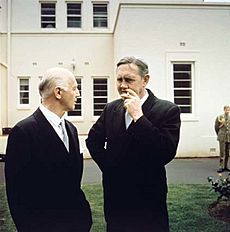
When Prime Minister Holt disappeared in December 1967, many thought McMahon would be the next leader. However, John McEwen, the temporary Prime Minister, said his party would not work with McMahon. McEwen did not trust McMahon and thought he favored free trade too much.
So, McMahon stepped aside, and John Gorton became the new Prime Minister. McMahon remained Treasurer. In 1969, after an election where the government almost lost, McMahon tried to become leader again but was not successful. He was then moved from Treasurer to Minister for External Affairs.
In March 1971, the Defence Minister, Malcolm Fraser, resigned and criticized Gorton. This led to a vote for the Liberal Party leadership. The vote was tied, and Gorton decided to resign as leader. McMahon was then elected leader and became Prime Minister. Gorton became his deputy leader.
William McMahon: Prime Minister (1971–1972)
McMahon became Prime Minister at a difficult time. The government had been in power for 22 years and people felt it was getting old and losing focus. One of his first challenges was dealing with John Gorton, who was now his deputy and Defence Minister. Gorton wrote articles criticizing the government, and McMahon eventually had to ask him to resign. Billy Snedden then became the new deputy Liberal leader.
McMahon faced a strong challenge from the Labor Party, led by Gough Whitlam. Labor had almost won the previous election and was seen as ready to govern. For the next year and a half, McMahon struggled against Whitlam. Whitlam was a very good speaker in parliament and often put McMahon on the defensive. Whitlam criticized the unpopular Vietnam War and suggested new policies like universal health care.
McMahon also faced rising inflation, which made people question his economic management. The Liberal Party itself was having disagreements, which was bad timing with an election coming soon. McMahon's voice and appearance on television were also not seen as very strong.
In June 1971, McMahon stopped a plan for a nuclear power program that Gorton had started. He felt it did not fit with the goals of the Nuclear Non-Proliferation Treaty.
As 1972 began, McMahon had to call a federal election. By then, Labor was far ahead in the polls, and McMahon's approval ratings were low. The media was also very critical of him. Many felt McMahon "did not look or sound like a Prime Minister." He waited as long as he could, but finally called the election for 2 December 1972.
During the election campaign, some of his own ministers did not support him, which was very unusual. The Liberal-Country Party government lost the election, ending their long time in power. McMahon conceded defeat on election night.
McMahon had been a minister for 21 years and 6 months without a break. This is a record in the Australian Government.
William McMahon: Later Years in Parliament
After losing the election, McMahon's time as Prime Minister ended on 5 December 1972. He did not immediately resign as Liberal leader, but it was clear he would not continue. On 20 December, the Liberal Party chose Billy Snedden as their new leader.
McMahon was still respected for his past service. He was included in Snedden's new shadow cabinet, but he did not ask for a specific job. In an interview in 1973, McMahon said that "disloyalty within our own party" was a main reason the Liberals lost the election. He also said he regretted not ending compulsory military service, how he handled the 1971 budget, and that he was not a good communicator.
After the 1974 election, McMahon became a regular member of parliament again. He strongly supported the power of the Senate to block government spending. However, he believed that Governor-General John Kerr acted wrongly in dismissing Prime Minister Whitlam in 1975.
McMahon stayed in parliament until January 1982. He was the longest-serving member of the House of Representatives at that time. In his final years, he often criticized the government led by Malcolm Fraser. He retired before the next election, partly because he was unhappy with the 1981 budget. He suggested Malcolm Turnbull as his replacement, but the Liberal Party chose someone else. The Labor Party won the election for his old seat.
William McMahon: Final Years and Legacy
Retirement and Passing
In retirement, McMahon spent much time writing his life story, which he planned to call A Liberal View. However, publishers did not accept it. In 1984, McMahon supported Bob Hawke and the Labor Party for re-election. He said the Liberal Party would not be ready to govern for several more years.
In his last years, McMahon had several operations for skin cancer. He passed away peacefully in his sleep on 31 March 1988, at St Luke's Private Hospital in Potts Point, New South Wales. His body was cremated. A public memorial service was held in Sydney on 8 April.
Family Life
In 1965, when he was 57, McMahon married Sonia Rachel Hopkins, who was 32. They had three children: Melinda, Julian, and Deborah. Julian McMahon is a well-known actor and model. Sonia passed away in 2010.
His Faith
McMahon was an Anglican. He became interested in religion as a teenager and read a lot about it. He often spoke about how his Christian beliefs connected with his political ideas. In 1953, he explained how he believed Christian teachings supported parliamentary democracy and a market economy.
How is William McMahon Remembered?
Many historians and political scientists often rank McMahon as one of Australia's less successful prime ministers. In 2001, most historians surveyed put him among their worst five prime ministers. Some of his former colleagues also openly criticized his leadership style.
However, some writers have defended McMahon. They argue he was a skilled politician who was unfairly blamed for an election loss that was likely to happen anyway. He was known for his energy and hard work. He was also recognized for his strong understanding of economic policy.
Gough Whitlam, who replaced McMahon as Prime Minister, said McMahon was "an extraordinarily skilful, resourceful and tenacious politician." Whitlam believed that McMahon's skills prevented the Labor Party from winning by an even larger margin in 1972.
Honours and Recognition
McMahon received several important honours:
- He became a Privy Counsellor in 1966.
- He was made a Companion of Honour in 1972.
- He was appointed a Knight Grand Cross of the Order of St Michael and St George in 1977.
In 2009, a federal electorate in New South Wales was renamed the Division of McMahon in his honour. This division was first used in the 2010 federal election.
Images for kids
-
McMahon with Prime Minister John Gorton in 1969
-
McMahon visiting US President Richard Nixon at the White House in 1971
-
Bust of McMahon by sculptor Victor Greenhalgh located in the Prime Minister's Avenue in the Ballarat Botanical Gardens
See also
 In Spanish: William McMahon para niños
In Spanish: William McMahon para niños
- McMahon Ministry


